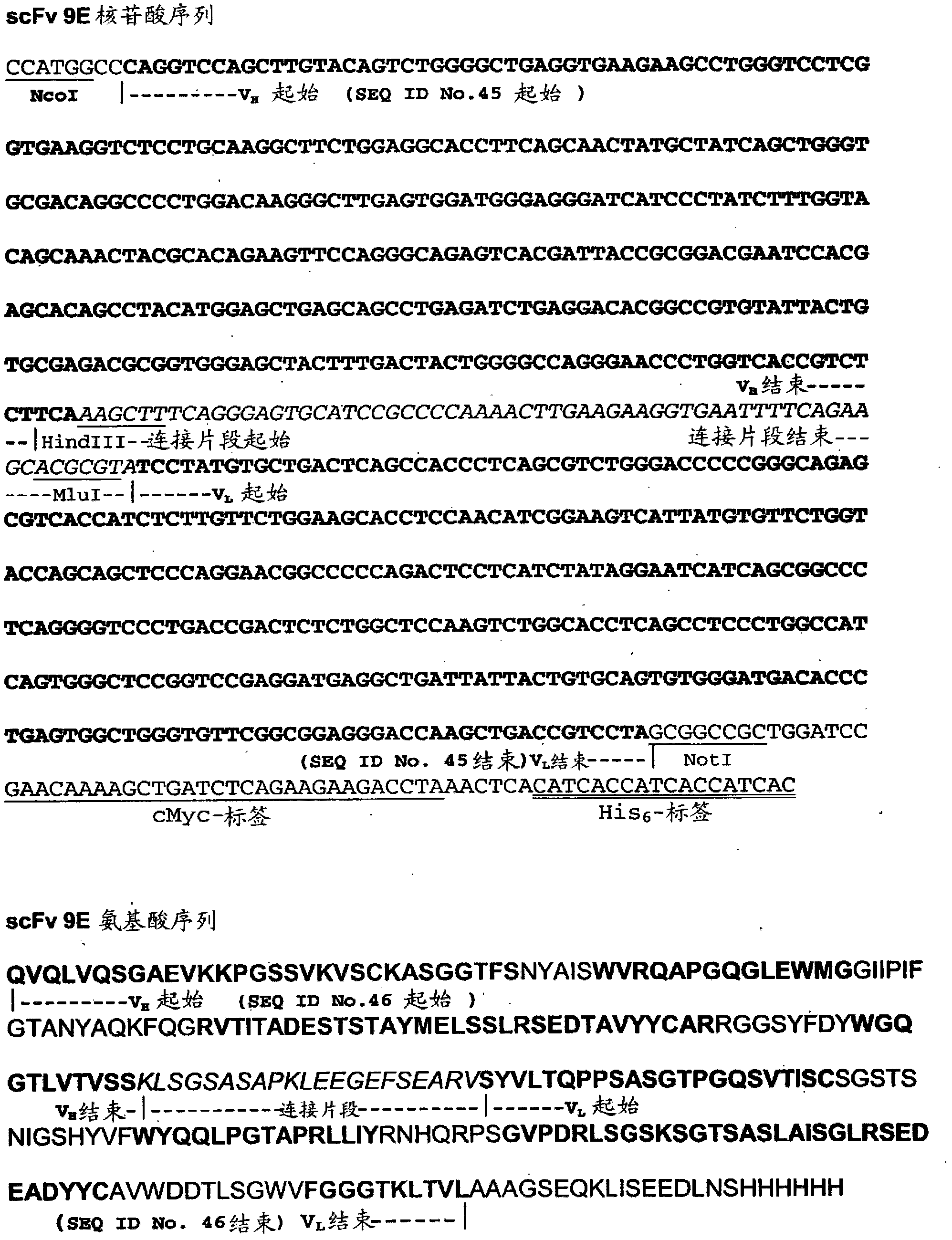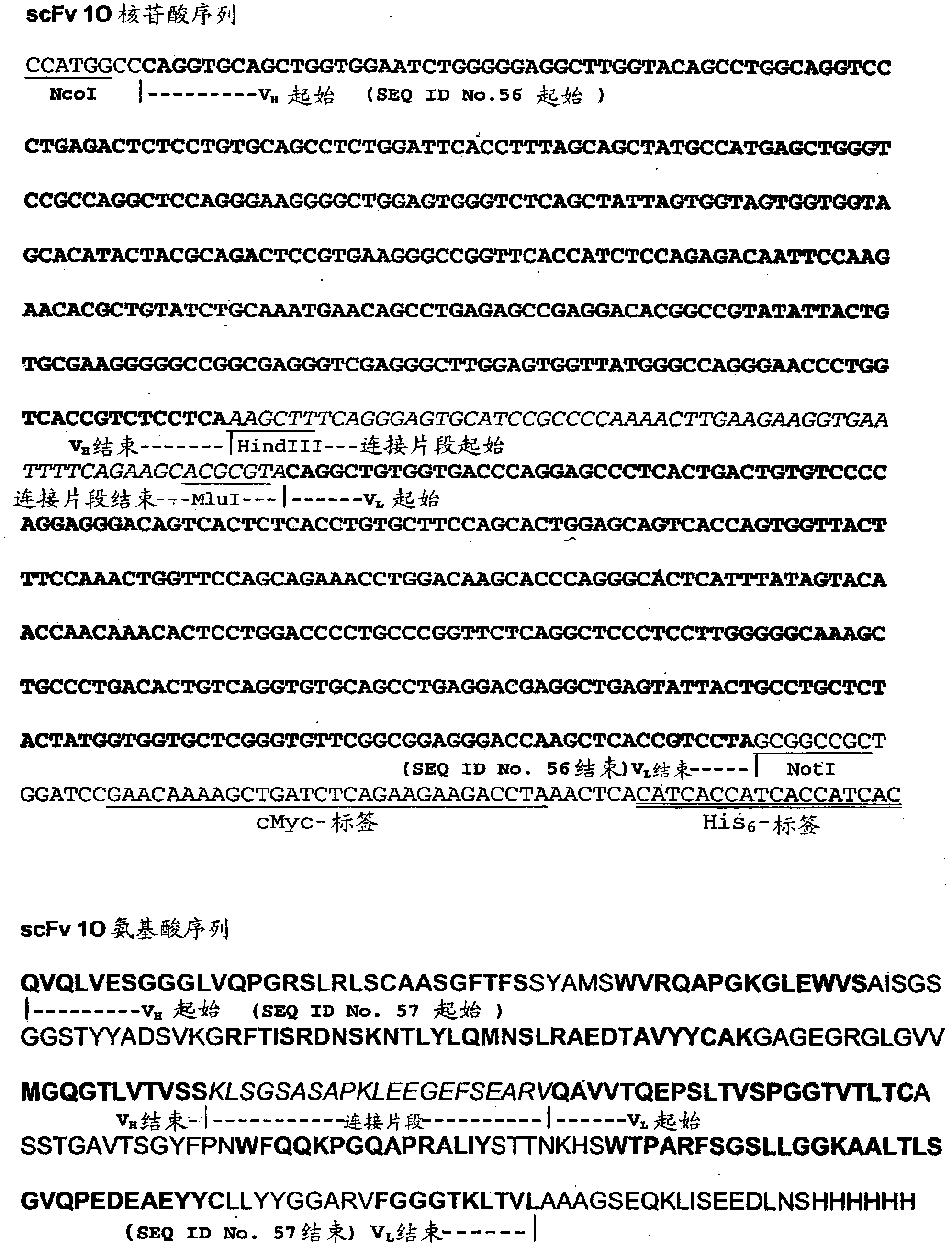Antibodies
An antibody, human antibody technology, applied in the direction of antibodies, antibody medical components, anti-inflammatory agents, etc., can solve problems such as lack of application
- Summary
- Abstract
- Description
- Claims
- Application Information
AI Technical Summary
Problems solved by technology
Method used
Image
Examples
Embodiment 1
[0683] Example 1: New Antibodies
[0684] Four human antibodies capable of specifically binding CCR4 have been identified. The single chain form of the antibody was cloned into the pHOG21 plasmid, which contains c-myc and 6 his-tagged epitopes. TG1 bacteria were transfected and scFv expression was induced with IPTG. Binding of purified scFv was confirmed by EasyCyte.
[0685] The nucleotide sequences of the heavy and light chains of the resulting cloned antibodies were sequenced. The antibodies were designated 17G, 9E, 11F, 10, 9E10J and 9E1D. The nucleotide and amino acid sequences of the light and heavy chains of 17G are in figure 1 shown in . The CDR domains of the light and heavy chains of 17G are shown in Table 1. The nucleotide and amino acid sequences of the light and heavy chains of 9E are in figure 2 shown in . The CDR domains of the light and heavy chains of 9E are shown in Table 2. The nucleotide and amino acid sequences of the light and heavy chains of...
Embodiment 2
[0690] Example 2: Binding of Anti-CCR4 Antibodies to Target Expressing Cells
[0691] To demonstrate the CCR4 specificity of the antibodies disclosed in Example 1 and to assess their binding affinities, IgG-forms of 17G and 9E and scFv 10 and 11F were used in flow cytometry for CCR4-internally transfected and non-CCR4-transfected HEK293T cells, DT40 cells and native CCR4 + CCRF-CEM cell line staining. As a positive control, an in-house cloned and expressed IgG form of KM3060var specific for an epitope present at positions 2-29 of the N-terminus of human CCR4 (EP1270595) was used. Anti-GFP antibody (raised against green fluorescent protein) or anti-VZN antibody (raised against varicella zoster virus) was used as negative controls (anti-GFP antibody was in scFv and IgG format, while anti-VAN was only in scFv format).
[0692] CCRF-CEM (acute lymphocytic leukemia, ATCC No. CCL-119), HEK293T / 17 (human kidney, ATCC No. CRL-11268), and DT40 (chicken lymphoma, ATCC No. CRL-2111) ...
Embodiment 3
[0700] Example 3: Anti-CCR4 Antibodies Interfering with Ligand Binding
[0701] To determine whether the anti-CCR4 antibody interferes with CCR4 ligand and receptor binding, MDCs (obtained from PeproTech EC Ltd., London, UK) were pre-incubated with CCR4-transfected DT40 cells prior to staining with scFv. As a negative control, KM3060var scFv (see Table 10 for sequence), which is specific for the N-terminal portion of human CCR4, was used. It was previously shown that the antibody KM3060 does not interfere with ligand-receptor binding (T Ishida et al. (2006) Specific Recruitment of CC Chemokine Receptor 4-Positive Regulatory T Cells in Hodgkin Lymphoma Fosters Immune Privilege, Cancer Res 66: (11): 5716-5722.). KM3060var corresponds to KM3060, but it is expressed in a different host cell, which may result in a difference in the sugar chain attached to this antibody.
[0702] CCR4+DT40 cells were harvested from the culture flask, washed twice with RPMI-1640 medium, and equal...
PUM
| Property | Measurement | Unit |
|---|---|---|
| affinity | aaaaa | aaaaa |
Abstract
Description
Claims
Application Information
 Login to View More
Login to View More - R&D
- Intellectual Property
- Life Sciences
- Materials
- Tech Scout
- Unparalleled Data Quality
- Higher Quality Content
- 60% Fewer Hallucinations
Browse by: Latest US Patents, China's latest patents, Technical Efficacy Thesaurus, Application Domain, Technology Topic, Popular Technical Reports.
© 2025 PatSnap. All rights reserved.Legal|Privacy policy|Modern Slavery Act Transparency Statement|Sitemap|About US| Contact US: help@patsnap.com



